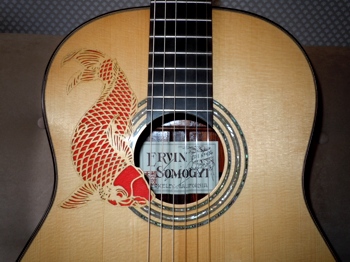F.A.Q. #2: Working Woods to a Stiffness
October 16, 2011
Q: Obviously, your method [of working tops to stiffness than to target dimension] is going to lead to different thicknesses for every piece of wood of a certain species to get the same flexibility. I am curious, though, if you find that different species have to be worked to a different degree of flexibility? For example, say you thin your steel string Sitka tops to have X amount of flexibility with a Y weight on them. Do you use the same X amount of flexibility when you are using Engelmann or Cedar, as well, or do you find that you need to develop a Z amount of flexibility for a different species? Thanks.
A: You’re correct that in theory no two pieces of topwood will wind up being exactly the same thickness if one follows my method. That is, we’re looking to achieve a consistent level of RESISTANCE, and different woods will have different proportions and densities of xylene, cellulose, and fiber with which to achieve that level of resistance.
This level of resistance isn’t some theoretical number that’s gotten by formula — although it can be gotten that way. The level of resistance is organic to the guitar: it is set by the top’s need to work with the strings’ pull, modulated by the kind of sound (character, sustain, overtones, etc.) that you might be after. And that’s all. Various gauges of strings, of various scale lengths, exert a certain amount of pull which, when excited, provide the motive force and energy budget. This is, of course, affected by things like how hard the player plays, bridge height and torque, etc. I don’t think any of this is exactly new information to anyone who’s been paying attention.
If the top is too resistant to the strings’ pull, then the mechanical response of the guitar is hampered. It is compressed into (i.e., limited to) regions of high-frequency/low amplitude activity/signal. You might or might not like that sound, but it will be a limited sound. If the top is too wimpy and flexible then it MIGHT have to rely on the bracing to restore its dynamic balance to a higher level of stiffness and hence response. The bracing will reinforce, or undermine, or overpower, what the top itself is able to do. It’s a partnership.
Steel strings on a guitar exert a pull of around 180 pounds. Nylon strings exert a pull of nearly 100 pounds. Let’s say that the strings on your guitar exert 125 pounds of pull and torque when tuned to pitch. I’m just grabbing a number here. Now consider: it really doesn’t matter whether your guitar has a Sitka spruce top, an Engelmann top, a redwood top, a European or Lutz spruce top, a cedar top, a koa top, a mahogany top, or a plywood top. That top is, in every case, going to be driven by 125 pounds of string pull/drive/torque. We’re assuming everything else being equal here: guitar size, soundhole size, bridge height, etc.
The question is: why would you put a top with any different stiffness (than that needed to deal with a 125 pound pull and torque) on your guitar? Put it another way: if string gauge were like octane in gasoline (i.e., a measure of its ‘oomph’) and top stiffness were like tire pressure (a certain ease or hardness in car maneuverability), then regardless of what octane gasoline you fill your car’s tank with, why would you change the tire pressure every time you gassed up?
Now, there are different things than mere stiffness going on. There’s also internal damping and mass. Different woods WILL behave a bit differently, at identical stiffnesses, when excited by strings, because of these other factors. Some woods will suck the strings’ energies up pretty quickly and damp their motions. Some will be vitreous and live and allow the strings to remain excited for longer. Some will be internally brittle. Some will be internally tough and ropey. Some will be very dense; others will be like Styrofoam, etc. You get the idea. So there’s a lot to be said for familiarizing one’s self with the average tonal potential of different woods, as well as which woods tend to be more consistent in qualities and which species have a wider, less consistent, range of qualities depending on which plank or log you’re working with. The main thing is to work with woods that have the least energy loss possible. You want the energy to go into the air (sound) and not into the woods and materials of the guitar.
If you’ve ever been to a lumber yard you’ll have noticed that some planks of a given wood are dense and heavy while other planks right next to them are not. Such things affect a guitar’s behaviors, and need to be factored into your calculations — if only to the extent of your using the same selections of woods on the guitars that you make. You may or may not have a clue as to what difference any characteristic that you’re aware of might make, but it’s smart to not throw uncontrolled variables into your work if you can help it.
Having said that, EVERY guitar will produce a monopole, a cross-dipole, a long-dipole, and whatever other mode of motion you think is important enough to consider. If you don’t know about these, please stop reading this right now and read up on these fundamental vibrational modes of a guitar top: they’re critical. Every guitar has SOME mix of these modes, and every guitar has a fixed energy budget with which to excite these — depending on how the maker has knowingly or ignorantly designed his system to ALLOW, FACILITATE, INHIBIT, SUPPORT or PREVENT certain movements of the top.
